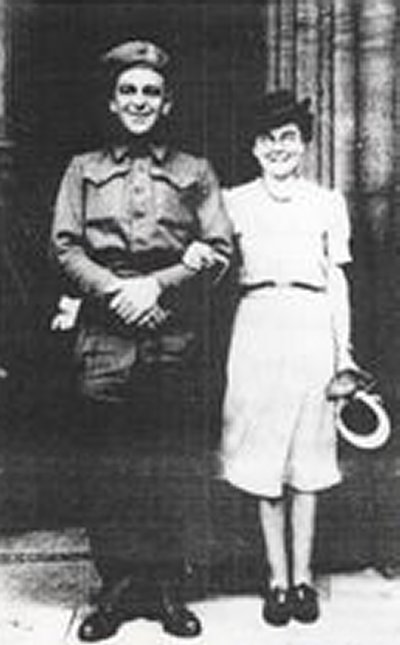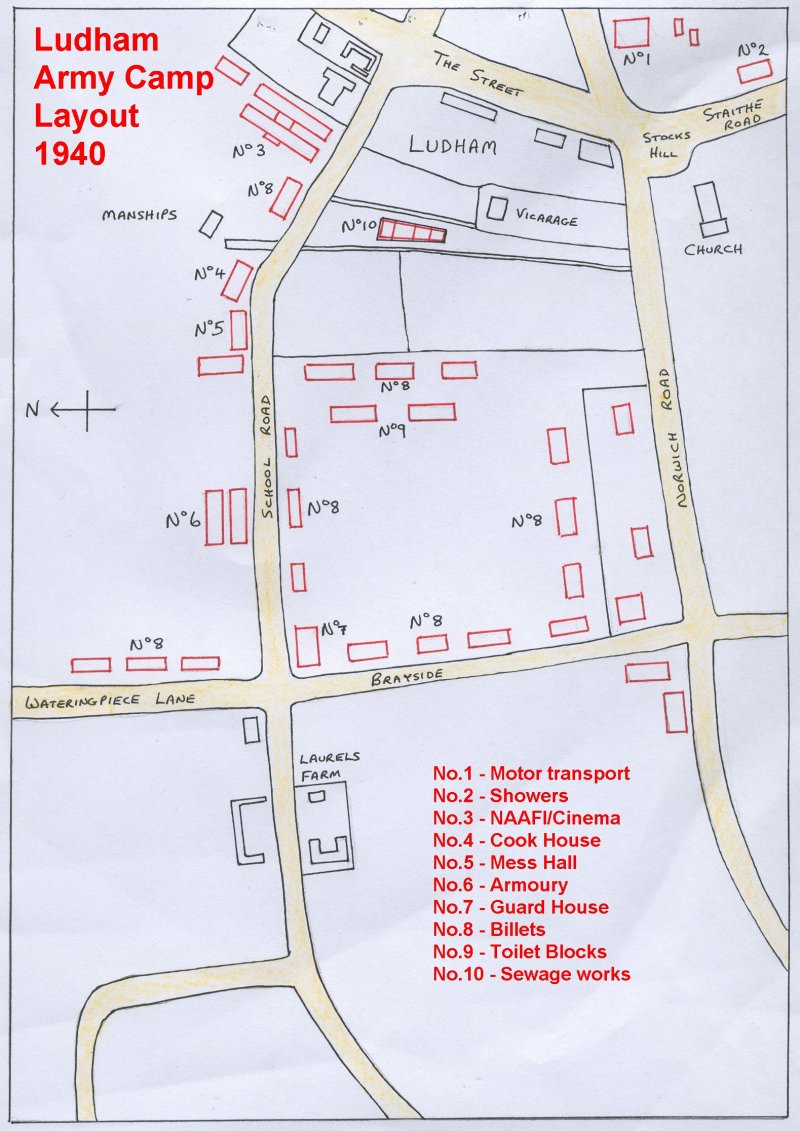
 |
Memories of the World War II Army Camp in Ludham |
The memories of Frank Graham World War II had a huge impact on Ludham Village. What had been a quiet rural place was suddenly transformed when an RAF airfield and an Army Camp were both built in the village. In July 2006, the Ludham Archive received a letter from Frank Graham telling us about his time at the Army Camp and how it led to him meeting his wife, Barbara. There is nothing quite like a first hand account to bring something to life and Frank's letter does just that. No amount of photographs or maps can really convey what life was like in those days. The camp was a big one but consisted of mainly temporary buildings. Not much remains now although you can see bits here and there if you know where to look. You can find more information about the remains of WWII in Ludham on this page. The camp was mainly on, what was then, fields to the west of the village, with some buildings in the grounds of Ludham Manor. There is a map below to help you orient yourself and picture the rows of nissen huts. We hope you enjoy Frank's memories, and if you have any memories of your own, please get in touch. |
 Frank and Barbara
|

A LETTER TO THE
LUDHAM ARCHIVE FROM FRANK GRAHAM ABOUT THE LUDHAM
ARMY CAMP
WRITTEN ON JULY 29TH 2006
Dear Ludham Archive
Many thanks for your
correspondence and revealing map of the camp.
The nissen hut my
company were housed in backed onto the School Road (8
opposite 6 on the map) and the guard room where we did
our guard duties was on the bridle path. I joined my
unit, the 6th Duke of Wellingtons, at the end of march
1944, after a spell in hospital, at which time the whole
unit was confined to camp preparing to take part in the
invasion of Europe, wherever and whenever that was to
be. Our duties were doing various exercises, map
reading, arms drill and in my case as a driver, water
proofing vehicles ready for beach landings,
Free time was virtually nil and the only place to go was
the NAFFI canteen on the camp and to go out into the
village, to go to a Sunday service, as I did. You were
obliged to sign out at the guard room stating where you
were going and what time you would be back. Once a week
a couple of trucks would take 20 men for a day out in
Norwich, but my turn never came round.
Meals were all taken in camp, but the food was good and
wholesome. As driver of the “ration truck” I did get to
Gt. Yarmouth regularly to take the Sgt. Cook to pick up
rations at the depot, but even that was under guard to
avoid pilfering.
On rejoining my unit at
the end of March, I landed by train at midday at Gt
Yarmouth station, a place quite unknown to me - a
Yorkshireman, and Ludham was just a name, so I went into
the first canteen I saw, and enquired of the young lady
serving tea (later my wife Barbara) what time the next
bus to Ludham was. She answered there was one a day at
7.30 from the market place which she would also be going
to Rollesby on. I joined her on the bus and we chatted
all the way. When she left the bus at Rollesby, she
kindly invited me round to her home, Barr Cottage, a
lonely thatched roof chocolate box type cottage on the
Martham road at Rollesby. I sneaked out of camp the
following Sunday afternoon, walked over to Rollesby and
spent a pleasant couple of hours with her. Thus a short
but difficult courtship followed. I was 29 she was 32,
and we made a go of it and decided to marry. Barbara
arranged for a wedding on September 29 1944 at
St.Nicholas' priory, Gt.Yarmouth. Unfortunately, the
priory was hit by a stray bomb and all services were
transferred to St. Peter's church where we married as
arranged and the photo above shows us leaving church.
When the balloon went up
and the invasion started on June 6th 1944, the Dukes
immediately struck camp and headed for the South Coast
to join the invasion. They entered France on D9 and
headed into action, but immediately ran into a long and
concentrated German artillery barrage in which the unit
was decimated. Out of 880 men who went into that wood,
Only 330 came out alive and unhurt, but even they were
so traumatised they were no longer fit for active
service.
I was spared this
carnage, being left behind at Ludham camp along with two
trucks and five other men with all the units stores not
needed in action. We were told we would join the unit
later, but owing to the situation never did. After a
fortnight we were moved into the old workhouse hospital
on Caister Road Gt.Yarmouth. This made it easier to see
Barbara as I met her at the Greenacre School where she
was a teacher. Unfortunately, this didn't last
long, as almost immediately after we married I was
posted to another unit, the 10th Welsh Regiment
stationed in Belguim and we straight away joined the
push into Germany and at the end of the war in Europe on
May 8th 1945, I was in Hamburg. Fortunately I managed to
avoid all that the desperate Germans threw at us and I
came through unscathed, although quite a number of my
fellow soldiers were killed or badly wounded and "got a
blighty" in other words a wound bad enough to send then
to hospital in England where we all longed to be after
five years of war. (but not in hospital).
However I was not to see
Barbara again until I was finally demobbed on Feb.6th
1946 when I joined her at the house she had set up in my
home town of Halifax, were we lived till she died aged
83 in 1996.after 52 years of marriage.
We did visit Gt.
Yarmouth during the intervening years for holidays at
the in-laws at 58 Nelson Road North, until their deaths
in 1968. Then it was once a year to meet Barbara's old
friend and her cousin Maurice Nicholson who still lives
in Priory Gardens.
sincerely
Frank Graham
This large green shed is still standing in the Manor
Grounds and was once part of the Motor Transport
department that Frank worked in. Lorries were kept in the
shed. (No1 on the map)
